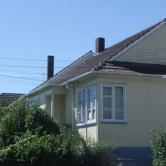1940s–1960s
The 1940s–1960s style was built from World War 2 until the 1960s and is typified by the early state house style.
Typical features of the 1940s–1960s house include:
- shallow, boxed eaves
- three or four-paned casement windows
- shallow recessed porches at front and back
- a piled subfloor
- hipped or gabled roofs – typically with a 30–40o roof slope
- tiled, asbestos-cement shingle or corrugated sheet roofing
- a concrete perimeter foundation wall
- typically bevel-back weatherboard cladding, but brick and asbestos-cement cladding were also used
- no insulation when built
- stud height was typically 2.4–2.7 metres
- no mechanical ventilation provided in bathrooms or kitchens
- plasterboard internal linings
- timber floorboards.
MAINTENANCE FOR 1940s–1960s HOUSES
Houses from this period, including state houses, were often well-built, and have been popular with homeowners wanting to renovate.
Regular maintenance required on 1940s–1960s houses includes:
- cleaning and checking the external cladding and repainting when necessary. See the guide for external wall maintenance
- cleaning and checking the roof cladding, and recoating if necessary. See the guide for roof maintenance
- ensuring gutters and downpipes are kept clear of leaves and other debris. If necessary, prune back any tree branches that grow over the house
- checking that the subfloor space is dry and well-ventilated. See the guide for subfloor maintenance.
More extensive maintenance/repairs on 1940s–1960s houses may include:
- Adding roofspace insulation where there is none or the existing insulation is insufficient.
- Replacing missing or damaged subfloor insulation. Use insulation designed specifically for subfloors. This includes polystyrene friction-fitted between the joists and segments such as polyester, glass wool or sheep’s wool fixed with tabs or held in place by strapping. Press insulation firmly against the floor so there is no air movement between insulation and floor. With exposed subfloors, fix sheet material under the insulation to hold it securely in place.
- Replacing missing or corroded fixings and connections between piles and bearers, and adding bracing between piles and bearers/joists for better earthquake resilience. See the subfloor maintenance guide for details.
- Asbestos-cement was used in the 1940s and 1950s for wall and roof claddings and also in the 1960s for floor coverings and spray-on textured ceilings. If your house has sheet cladding from this period (including corrugated cement-based roof cladding) or sparkly textured ceilings, check whether they contain asbestos before working on them. You can find more information on the asbestos page.



